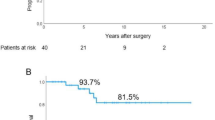Abstract
Exacerbations of myasthenia gravis (MG) in patients during radiotherapy for thymoma have never been adequately documented. This study aimed to identify potential risk factors for the occurrence of MG exacerbation during irradiation and to determine whether MG exacerbation during radiotherapy could affect the long-term clinical outcome of these patients. A total of 51 thymoma patients with MG receiving postoperative radiotherapy from January 2000 to March 2013 were retrospectively reviewed. Variables potentially affecting the occurrence of MG exacerbation were evaluated using Chi-square test or student’s t test. The difference in the chance of achieving complete stable remission (CSR), pharmacologic remission (PR), and general remission (GR) in the patients with and without MG exacerbation was determined by the log-rank test. Fifteen patients deteriorated during the irradiation. Univariate analysis showed that the MG duration between MG onset and irradiation was significantly longer in patients with MG exacerbation than patients without it (p = 0.029). The ratio of patients with a history of myasthenic crisis and bulbar symptoms were also higher in patients with exacerbation of MG than patients without exacerbation of MG, although it did not reach statistic significant. The log-rank test revealed that patients without MG exacerbation had higher PR and GR rates (p = 0.017 and p = 0.009, respectively). The worsening of symptoms appears to be related to the longer MG duration and more severe MG before irradiation. Moreover, the patients with MG exacerbation had a worse prognosis compared with patients without MG exacerbation. Our study highlights the need for preventing the occurrence of MG exacerbation in these patients.


Similar content being viewed by others
References
Farrugia ME, Vincent A (2010) Autoimmune mediated neuromuscular junction defects. Curr Opin Neurol 23:489–495
Vincent A, Bowen J, Newsom-Davis J, McConville J (2003) Seronegative generalised myasthenia gravis: clinical features, antibodies, and their targets. Lancet Neurol 2:99–106
Maggi L, Andreetta F, Antozzi C, Baggi F, Bernasconi P, Cavalcante P, Cornelio F, Muscolino G, Novellino L, Mantegazza R (2008) Thymoma-associated myasthenia gravis: outcome, clinical and pathological correlations in 197 patients on a 20-year experience. J Neuroimmunol 201–202:237–244
Ogawa K, Uno T, Toita T, Onishi H, Yoshida H, Kakinohana Y, Adachi G, Itami J, Ito H, Murayama S (2002) Postoperative radiotherapy for patients with completely resected thymoma: a multi-institutional, retrospective review of 103 patients. Cancer 94:1405–1413
Zhu G, He S, Fu X, Jiang G, Liu T (2004) Radiotherapy and prognostic factors for thymoma: a retrospective study of 175 patients. Int J Radiat Oncol Biol Phys 60:1113–1119
Wu KL, Mao JF, Chen GY, Fu XL, Qian H, Jiang GL (2009) Prognostic predictors and long-term outcome of postoperative irradiation in thymoma: a study of 241 patients. Cancer Invest 27:1008–1015
Akoum R, Brihi E, Chammas S, Abigerges D (2003) Results of radiation therapy for thymoma based on a review of 27 patients. Mol Immunol 39:1115–1119
Lysandropoulos AP, Mavroudakis N (2012) Exacerbation of myasthenia gravis after postoperative radiotherapy for a thymoma. Acta Neurol Belg 112:65–66
Ishida S (1996) Changes in clinical and immunological status after post-thymectomized irradiation for invasive thymoma with myasthenia gravis. Rinsho Shinkeigaku 36:629–632
Yu L, Zhang XJ, Ma S, Jing Y, Li F, Krasna MJ (2012) Different characteristics of thymomas with and without myasthenia gravis. Ann Surg Oncol 19:94–98
Liu Z, Feng H, Yeung SC, Zheng Z, Liu W, Ma J, Zhong FT, Luo H, Cheng C (2011) Extended transsternal thymectomy for the treatment of ocular myasthenia gravis. Ann Thorac Surg 92:1993–1999
Detterbeck FC (2006) Clinical value of the WHO classification system of thymoma. Ann Thorac Surg 81:2328–2334
Rosai J, Sobin LH (1999) Histological Typing of tumours of the thymus. World Health Organization. International Histological Classification of Tumours Springer Berlin Heidelberg
Jaretzki AR, Barohn RJ, Ernstoff RM, Kaminski HJ, Keesey JC, Penn AS, Sanders DB (2000) Myasthenia gravis: recommendations for clinical research standards. Task Force of the Medical Scientific Advisory Board of the Myasthenia Gravis Foundation of America. Neurology 55:16–23
Liu GC, Gao BL, Yang HQ, Qi GY, Liu P (2014) The clinical absolute and relative scoring system-a quantitative scale measuring myasthenia gravis severity and outcome used in the traditional Chinese medicine. Complement Ther Med 22:877–886
Acknowledgments
This work was supported by grants from the China National Natural Sciences Foundation (30870850, 81071002, 81371386) and the Clinical study of 5010 plan of Sun Yat-sen University (2010003). Yan Li and Pei Chen both contribute equally to this study. The work is also attributed to the Guangdong Key Laboratory for Diagnosis and Treatment of Major Neurological Diseases, National Key Clinical Department, National Key Discipline, Guangzhou 510080, China. We wish to thank Dr. Pamela Clark for her invaluable help in editing language.
Author information
Authors and Affiliations
Corresponding author
Ethics declarations
Conflict of interest
The authors declare that they have no conflict of interest.
Rights and permissions
About this article
Cite this article
Li, Y., Chen, P., Ding, L. et al. Clinical outcome and predictive factors of irradiation-associated myasthenia gravis exacerbation in thymomatous patients. Neurol Sci 36, 2121–2127 (2015). https://doi.org/10.1007/s10072-015-2325-8
Received:
Accepted:
Published:
Issue Date:
DOI: https://doi.org/10.1007/s10072-015-2325-8




